In the verdant sprawl of southern Ukraine, where golden sunsets embrace the horizon, a land sculpted by the toils and dreams of its people, my journey to uncover a remarkable story began. Compelled by whispers of Ukrainian sumo wrestlers ranking second in the world - a stunning feat considering the 80 countries participating - I travelled from Kyiv to Yuzhnoukrains’k. This was not just a trip; it was a pilgrimage to understand the enigma behind Ukraine's prowess in a sport so entrenched in Japanese tradition.
The odyssey spanned two marshrutkas in a single day, culminating at a nondescript fuel station where Anatolii, a man of extraordinary mettle, greeted me. A champion Ukrainian sumo wrestler, a father with a burgeoning family, and a soldier serving his nation, he personifies the spirit and heart of Ukraine – a paragon who is unyielding and full of heart. With a genial smile, he welcomed me into his world — a humble training ground far from the grandeur of sumo's origins. His life is a narrative of combat and compassion, unfolding in the sumo ring and on the front lines of a nation's quest for peace.
As the evening light waned, casting long shadows across the mats, Anatolii donned his black mawashi, setting him apart from his peers in white.
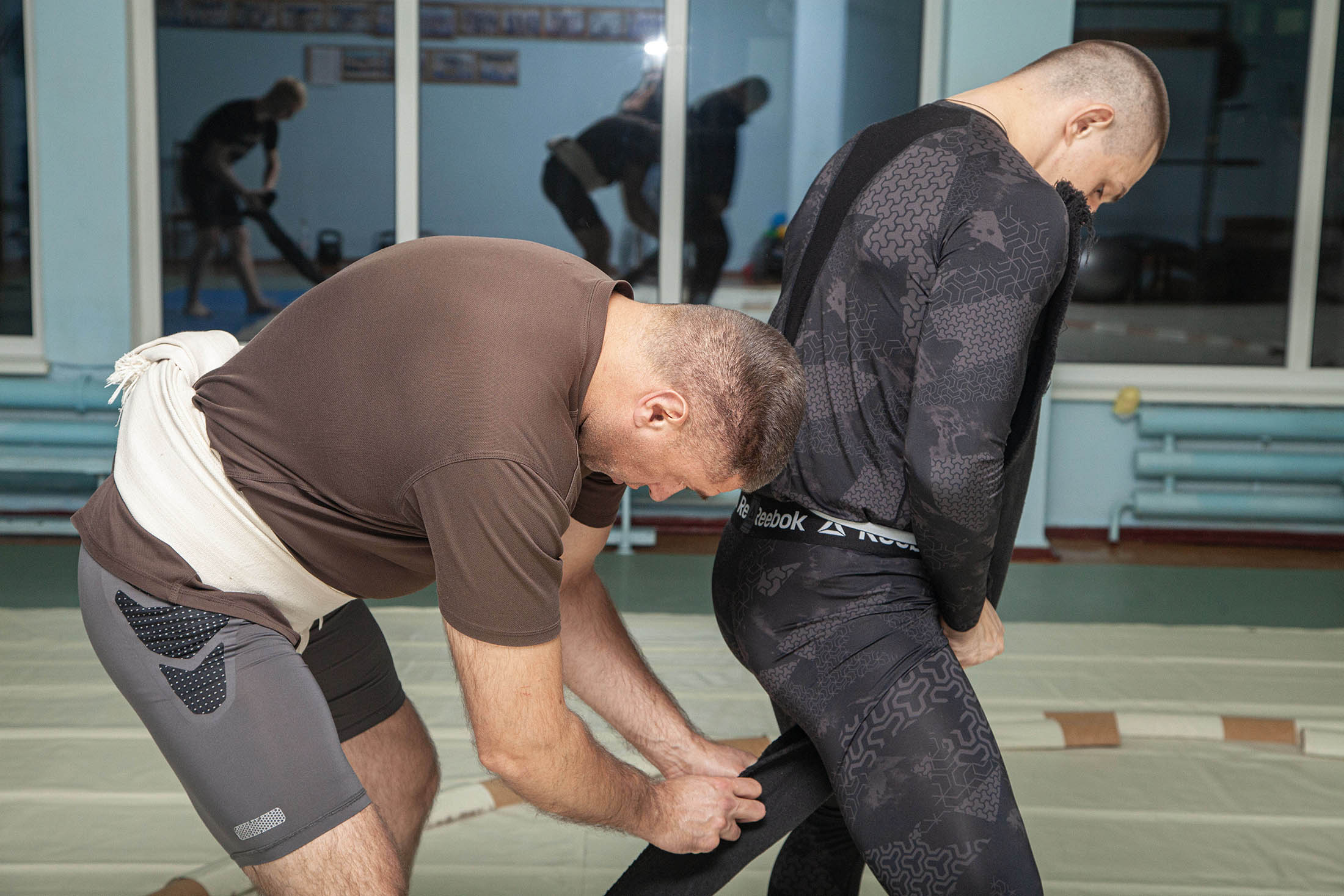
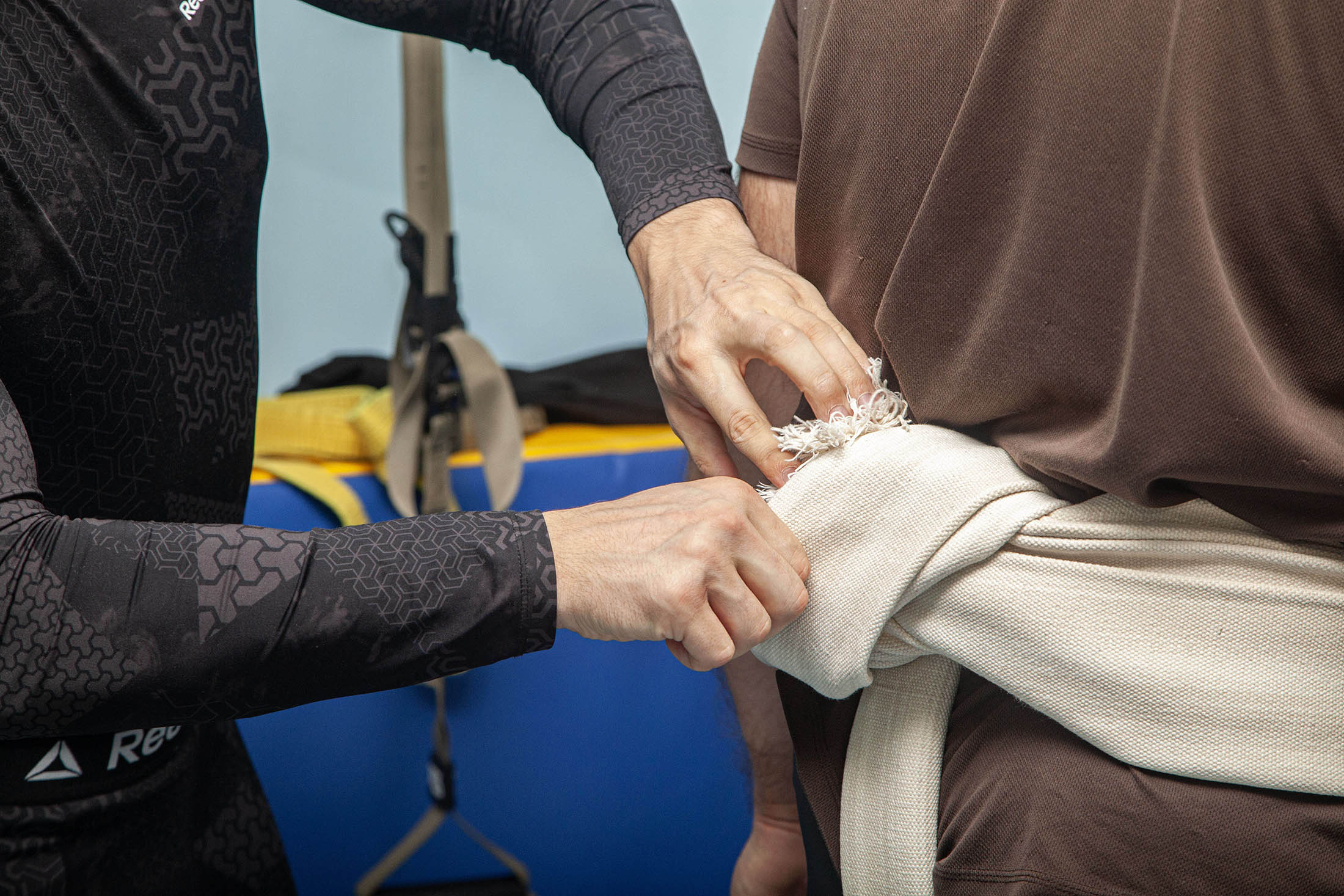
Their training attire, complete with spandex for comfort, belied the traditional form they would embrace in competition — nude, save for the mawashi. This adherence to sumo's roots, juxtaposed with the modern nuances of their practice, painted a vivid picture of a sport in cultural transition.
A Kinetic Sculpture of Strength and Honour
To observe Anatolii is to be granted an audience with power personified. Clad in black spandex that clings to his skin like a second, sinuous layer, every contour and sinew of his muscular form is pronounced, whispering tales of gruelling training and indomitable will. His presence is both a promise and a proclamation — a testament to the potential of human strength and the quiet dignity of the warrior's path.
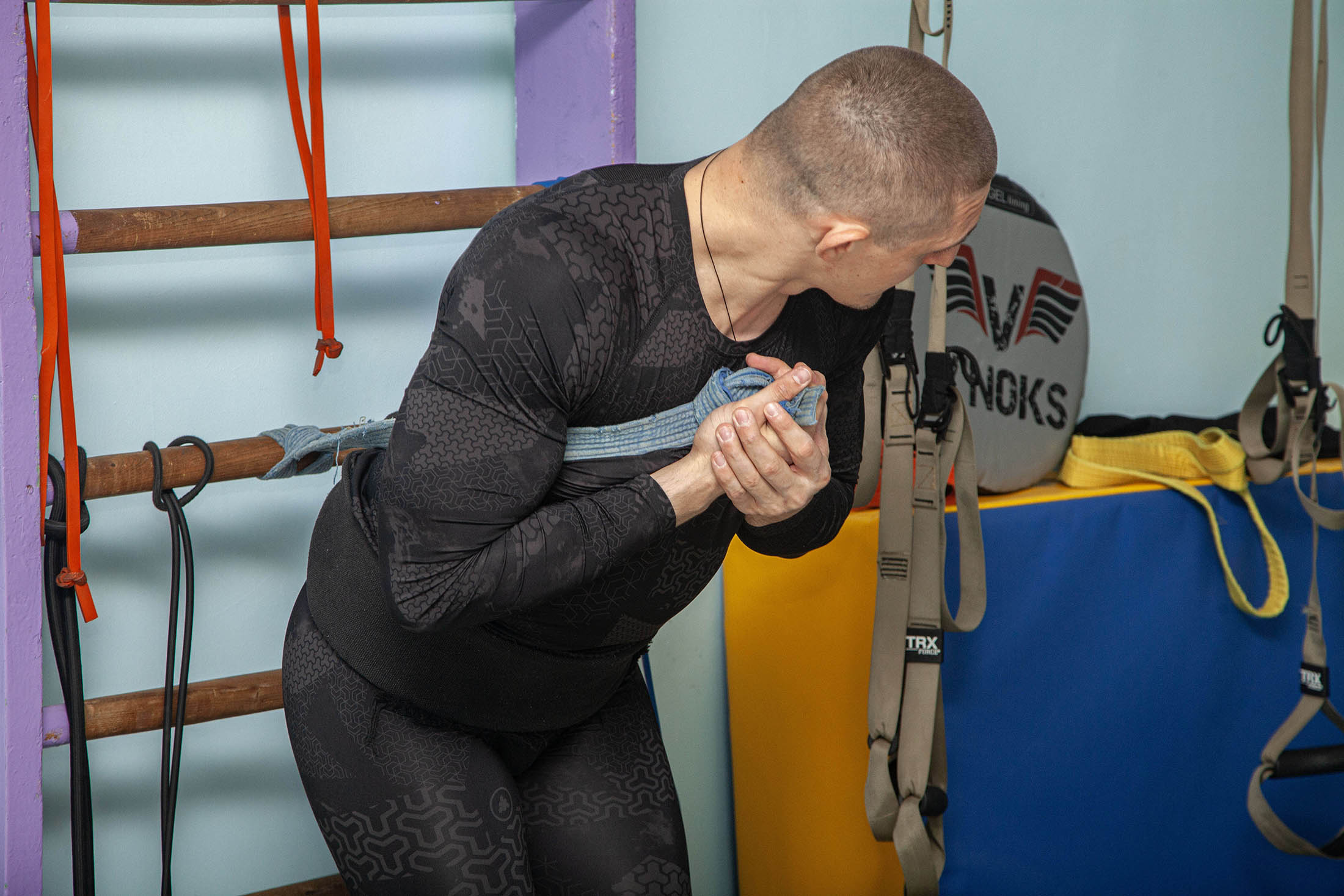
In the muted light of the training dojo, Anatolii’s preparation is a ritual in itself. The black mawashi, a swath of fabric that is both his garb and his armour, is wrapped around his waist with precise, practiced motions. His hands, firm and unwavering, are those of a sculptor shaping his own form, binding the mawashi with an almost sacred reverence. This fabric is the sole barrier between the wrestler and the vulnerability of the ring, a stark canvas upon which the story of the bout will be painted.
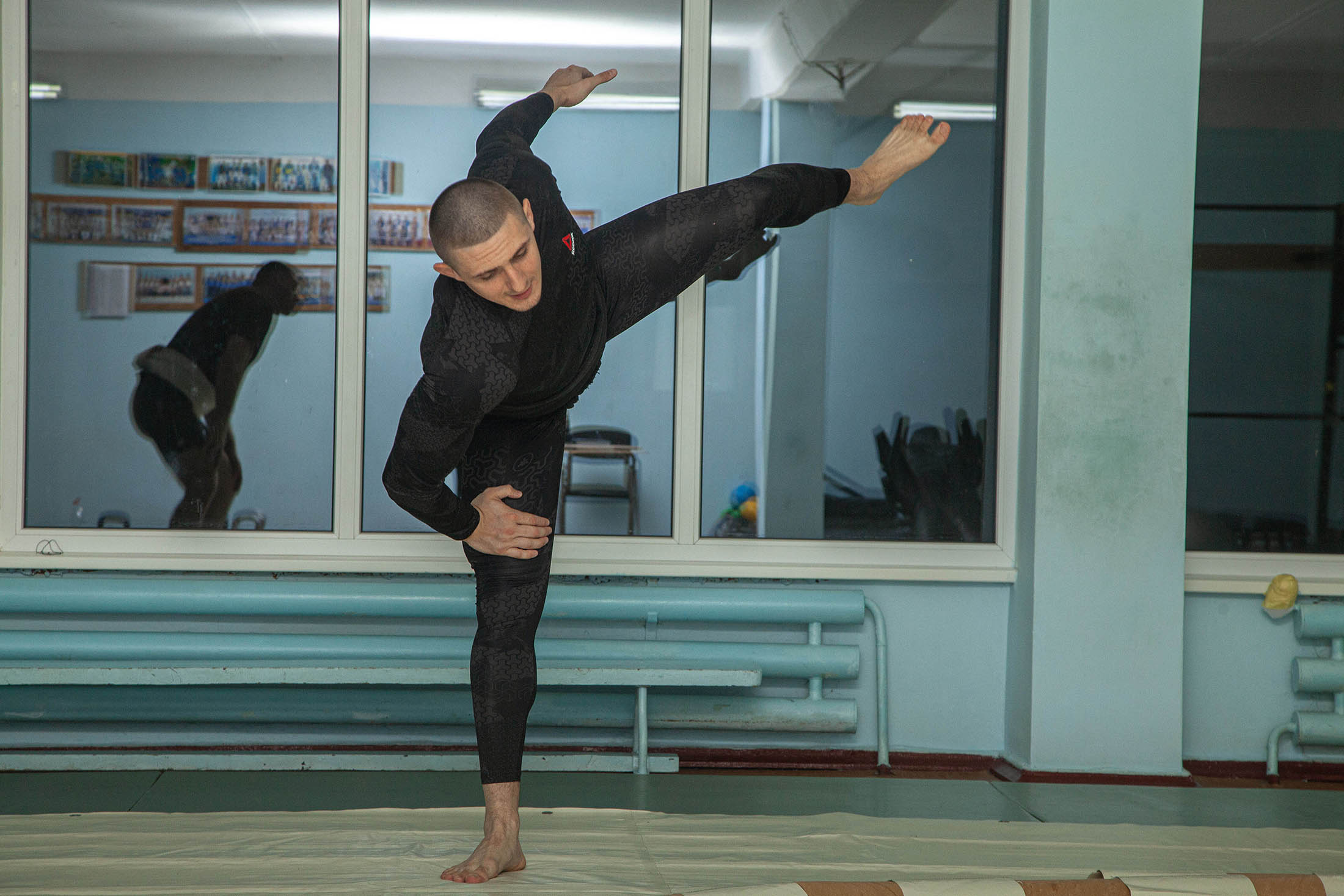
With each movement, Anatolii's body speaks. It speaks of a legacy steeped in the dust of the dohyō, of a lineage of wrestlers who have graced the sumo ring with their might. His stance is resolute, a bulwark against the onrush of combat. When he lunges or pivots, there's a grace that belies his robust frame, a harmony of motion that only the truly dedicated can achieve.
As he trains, the others — clad in white, the yin to his yang — surround him. They move together, a dance of combatants in training, their bodies in conversation with each other and the ancient sport they practice. But it is Anatolii who commands the space, his black mawashi a silent sentinel amid the white, his body a fortress of controlled power.
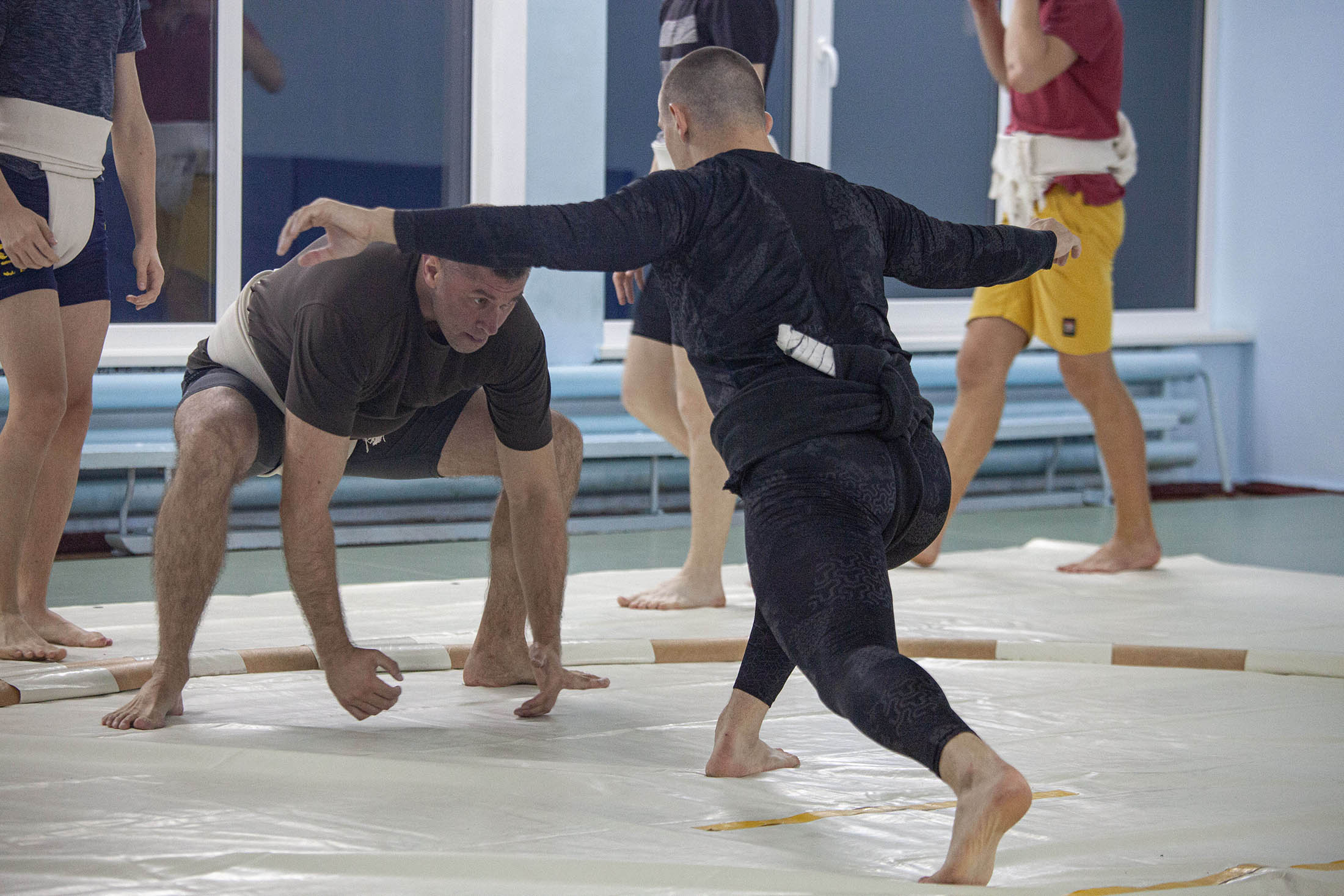
The dohyō, where the thud of bodies and the shout of effort rebound off the walls, is where Anatolii's dual life converges. Here, he is both a sumo wrestler preparing for his next challenge and a soldier whose discipline is as much a part of him as his heartbeat. The stark contrast of his combat-ready physique, wrapped in the black mawashi, against the peaceful backdrop of the training room, mirrors the dichotomy of his existence — fighting for glory in the ring and for peace in his homeland.
His muscles ripple with the narrative of countless hours of discipline; each movement is a verse in the poetry of combat. Yet, the dohyō where he shines with the polished gleam of a well-earned champion's patina is a stark contrast to the war-torn reality that shadows Ukraine's present days. Anatolii, a man who grapples with foes in the ring and faces the spectre of conflict when the mawashi is laid to rest, stands as a guardian of more than just the ancient sport he adores — he is a protector of his family and his country.
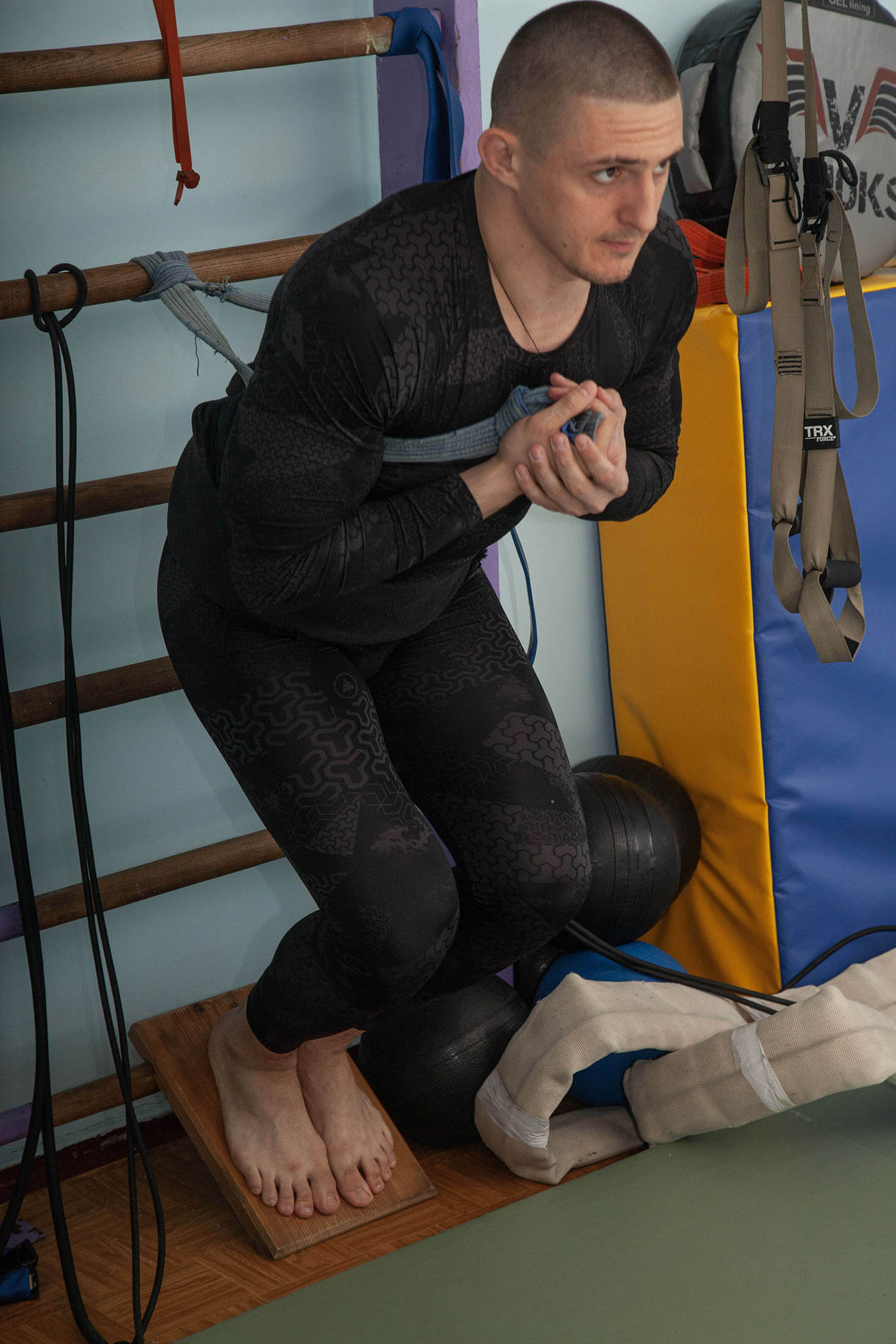
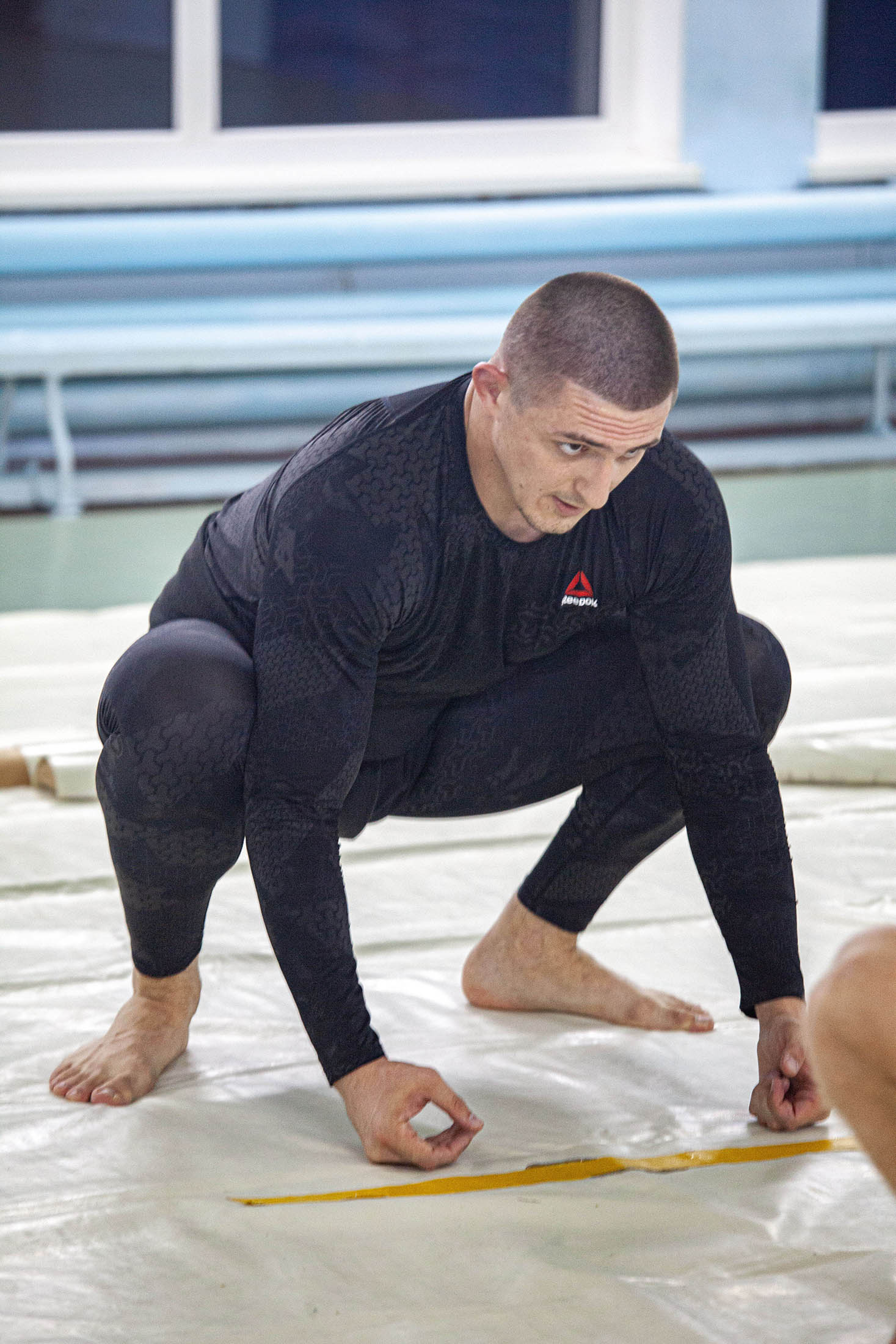
To watch Anatolii in the dohyō is to witness a kinetic sculpture of human strength in motion.
Anatolii’s Rise: The Making of a Ukrainian Sumo Wrestler - A Childhood Dream, Cast in the Mould of Heroes
The spark that ignited Anatolii's passion for sumo wrestling was as unlikely as a whisper of fate on a boisterous wind. "My interest in judo and sumo wrestling began when I was a child," Anatolii recounts, the nostalgia palpable in his voice. In the rustic ambiance of his childhood, silver-screen celluloid heroes danced across the television, their might and martial prowess igniting a fire in the young boy's heart. "I initially started with judo, inspired by movies featuring Jackie Chan, Jean-Claude Van Damme, Arnold Schwarzenegger, and others. I wanted to be as strong as they were."
With the wisdom and foresight only a father possesses, Anatolii was steered away from the path of karate and towards the grappling arts. His father believed judo would hone his burgeoning strength. Yet, it was the allure of sumo, with its blend of raw power and ceremonial grace, that ultimately captured his soul. "My father was right," Anatolii says, a smile creasing his face as he recalls his first foray into the art that would define his life's path. "Wrestling was my calling."
Defying Stereotypes: The Sumo Aesthetic
In the realm of sumo, where physicality is often equated with sheer size, Anatolii presents a contrasting image. Defying the traditional stereotype of sumo wrestlers being predominantly large and heavy, Anatolii's approach is a blend of strength, agility, and a muscular build.
"Regarding weight, this can be considered a stereotype, as sumo is both professional and a sport, just like professional and sportive boxing," Anatolii explains, addressing common misconceptions about sumo wrestlers. He points out that, unlike professional sumo in Japan, which doesn't categorise wrestlers by weight and is deeply rooted in cultural tradition, the sportive aspect of sumo, in which he competes, does have weight categories, and not all wrestlers are overweight.
"And what's better, to be healthy and overweight or in muscular shape? There's no definitive answer. It's important to find a healthy balance," Anatolii states. He advocates for a balanced approach, emphasising the importance of health and fitness over fitting into a conventional sumo wrestler's physique.
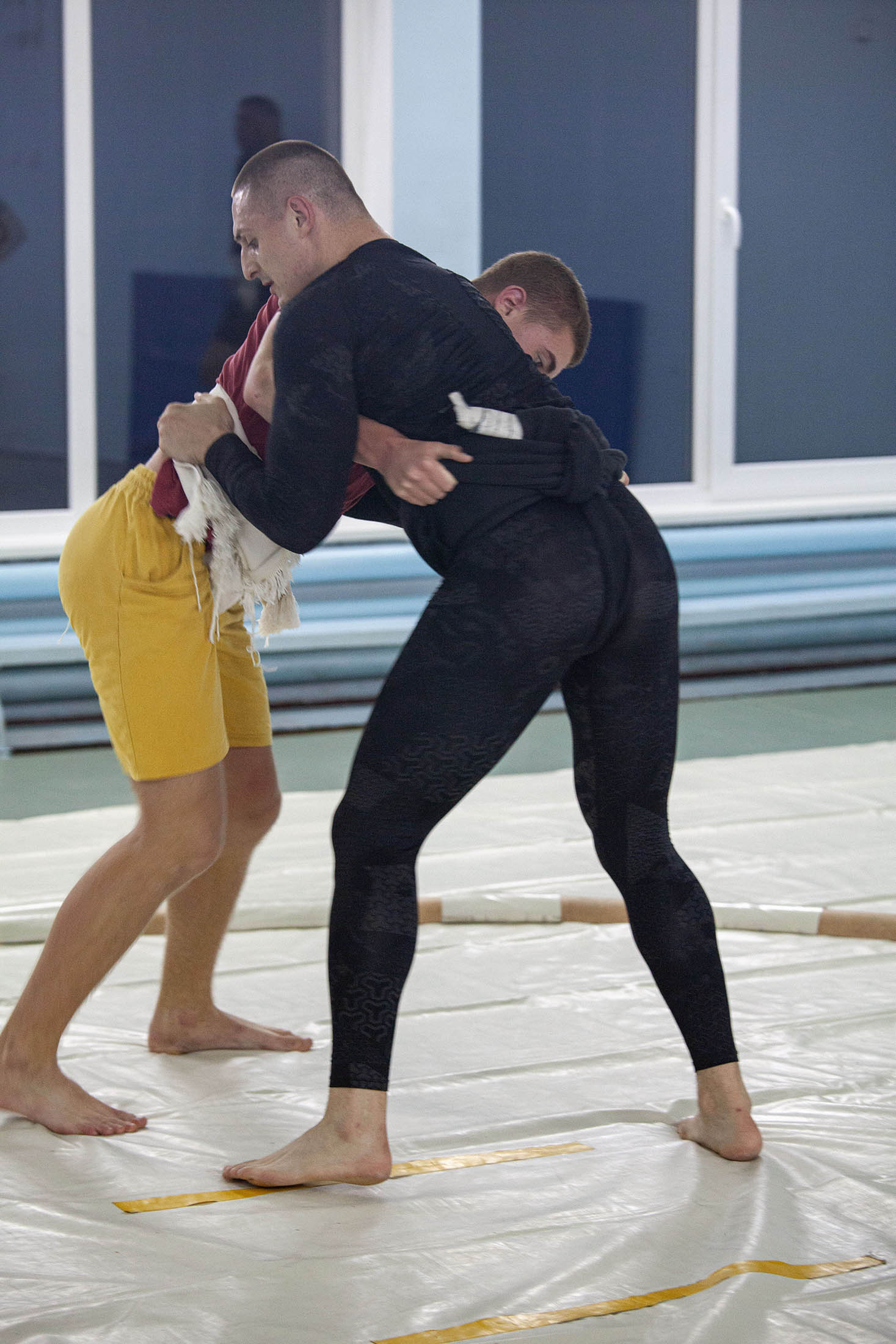
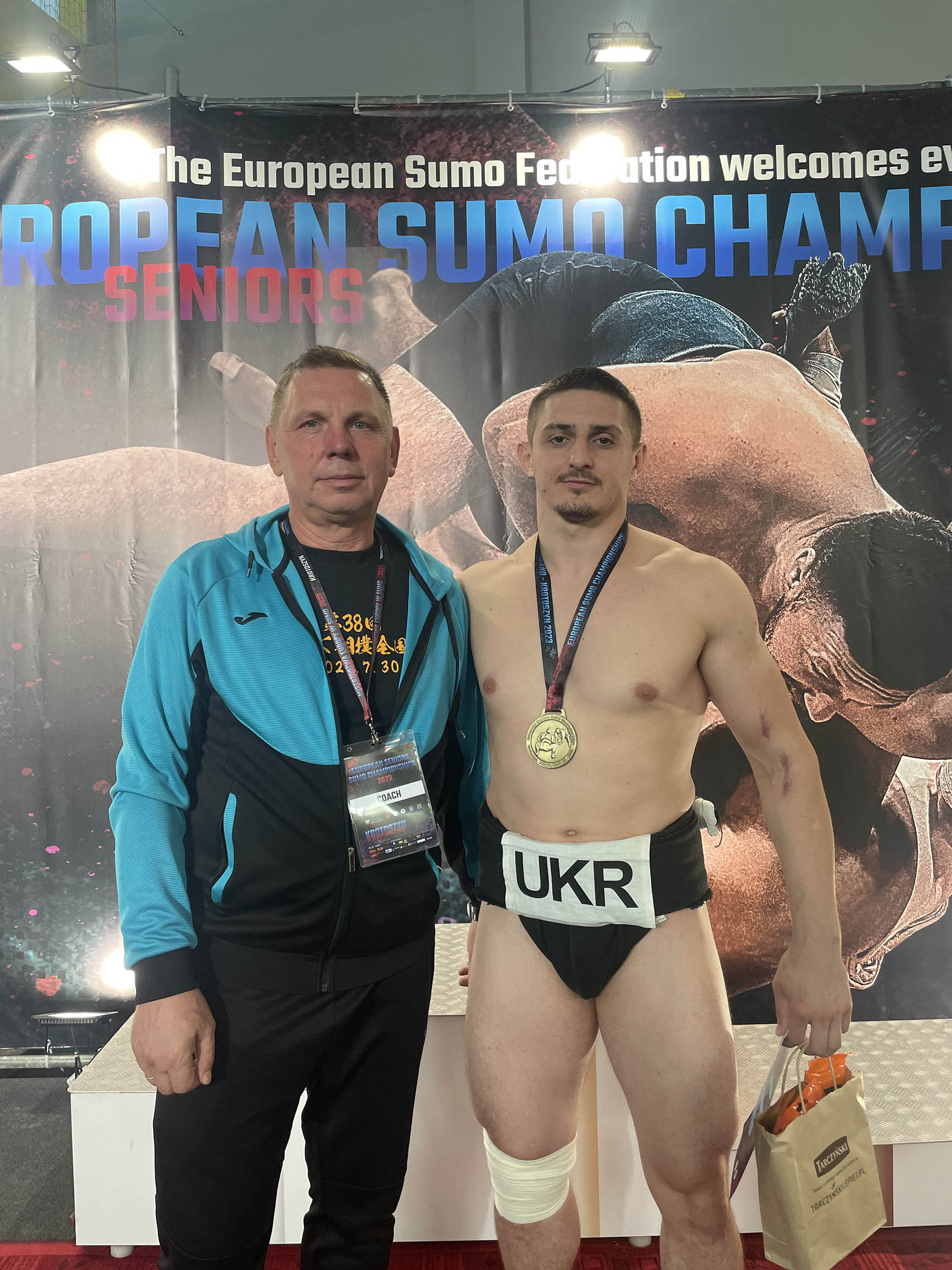
Anatolii's perspective on physical fitness in sumo reflects a broader shift in attitudes towards health and athleticism in sports. By focusing on a more muscular build, he embodies a modern approach to sumo, embracing its dynamic and fast-paced nature. His training regimen and physique underscore his commitment to maintaining peak physical condition, respecting the sport's demands while prioritising his health and performance.
In Anatolii's view, sumo is more than a contest of mass; it's a dynamic sport where agility (including inertia), strategy, and physical prowess are equally crucial. His stance challenges preconceived notions and opens a dialogue about the diversity of body types and techniques within the ancient art of sumo wrestling.
The Sumo Mindset: Mental Fortitude in and out of the Ring
In the world of sumo, the mental game is as critical as the physical. Anatolii, through his experiences, sheds light on the psychological resilience required both inside and outside the ring. His words offer a window into the mindset of a sumo wrestler, where mental strength is paramount.
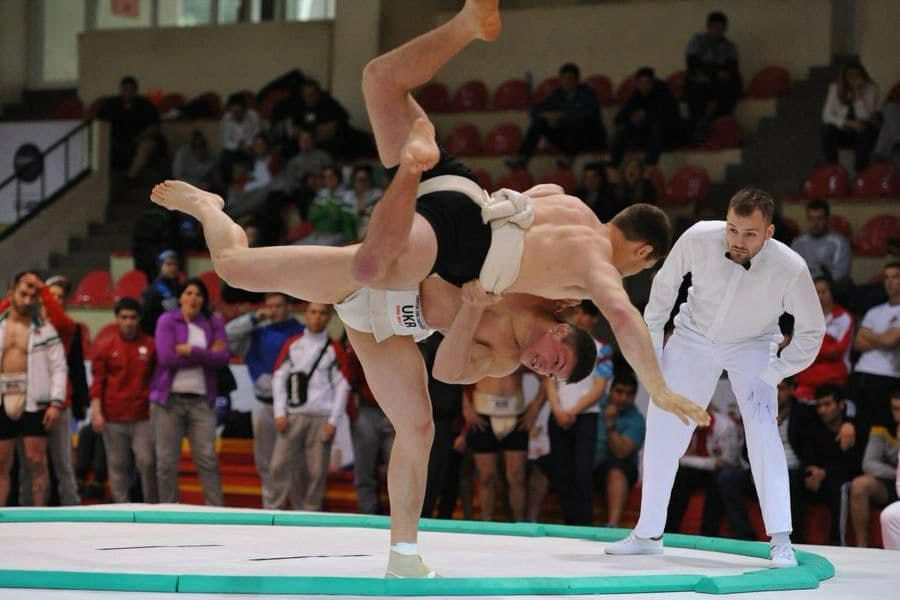
"Sumo contributes significantly to mental and physical health. It's great because when you prepare every day, train, and then compete, you derive a lot of satisfaction from it. It's like a drug.” His narrative emphasises the integral role of mental wellness in the life of a sumo wrestler.
When discussing the holistic well-being that sumo fosters, Anatolii touches on both the risks and rewards of the sport. "Yes, they exist. It's not just physical activity; it's a professional sport. Like any other sport, there are significant risks,” he acknowledges, gesturing to a prominent scar on his left arm - a memento of surgical intervention following a sumo injury.
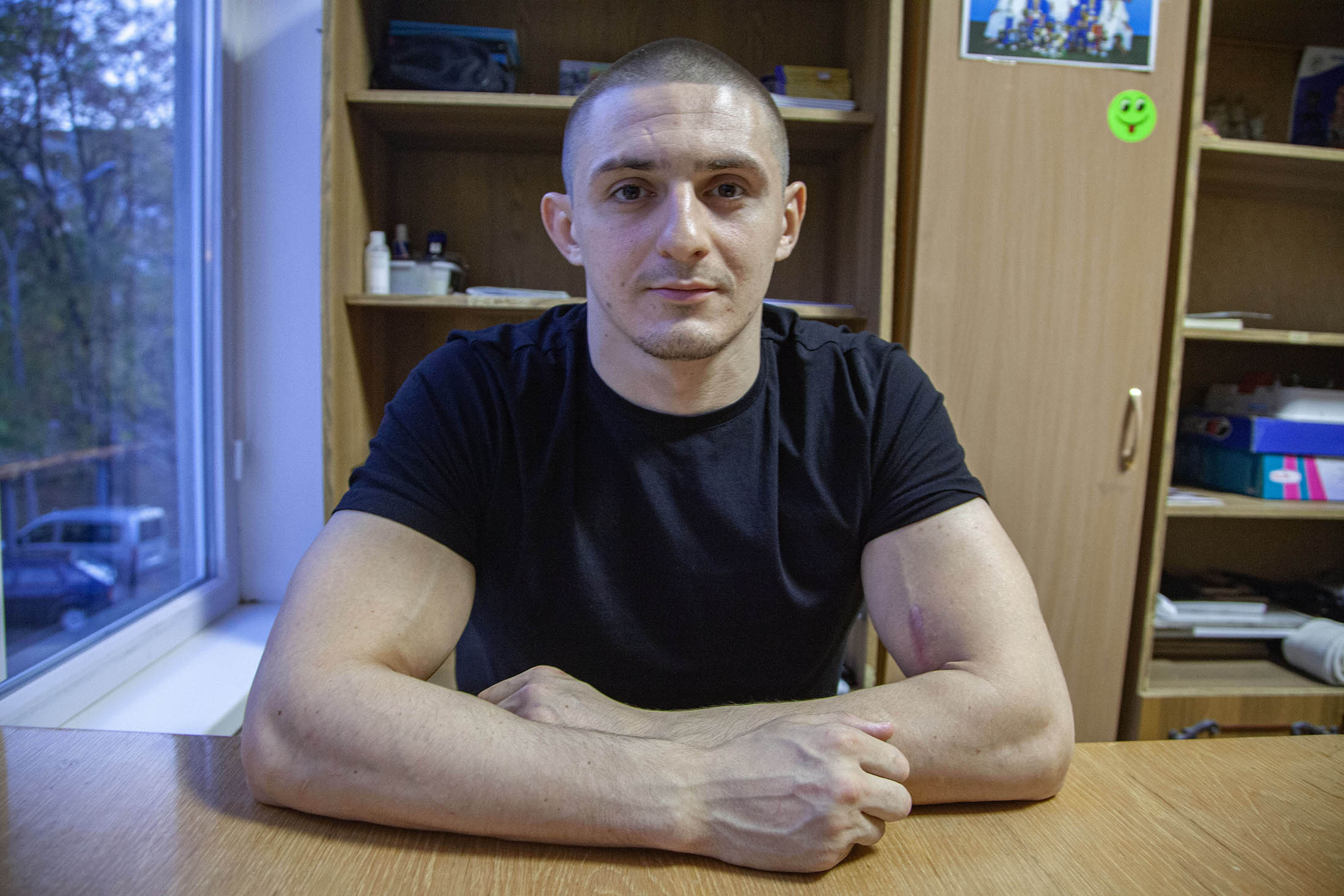
Over dinner, after a rigorous training session, Anatolii shares the story behind the scar, a vivid illustration of the sacrifices made in the pursuit of this demanding sport. Yet, even as he recounts the injury, his tone bores no regret, only the deep sense of fulfilment that sumo brings to his life.
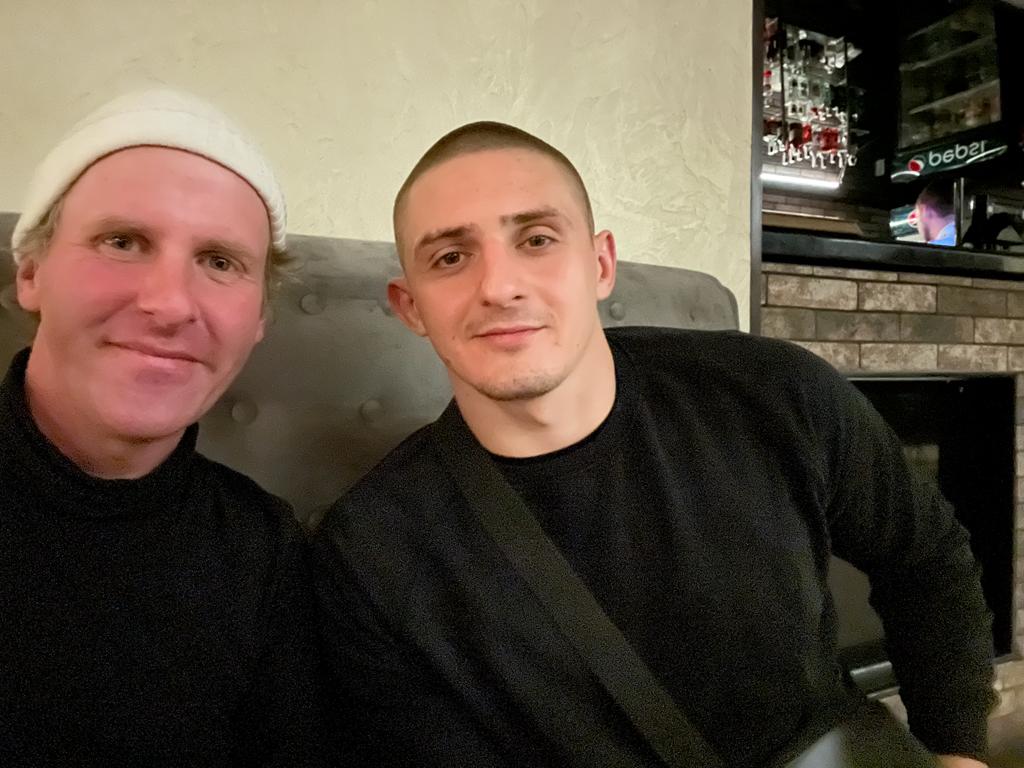
His insights into the mental preparation necessary for sumo reflect a deep understanding of the sport's demands. “It's an incredible feeling of satisfaction, but if you lose, it's disappointing because you've put in so much work to achieve victory.” Anatolii’s words reveal the emotional rollercoaster of competition, where victories are savoured, and defeats provide lessons for growth and improvement.
Through Anatolii's perspective, sumo emerges as more than just a physical contest. It is a mental and emotional journey, a discipline where each wrestler must cultivate resilience, focus, and the ability to find joy and learning in every challenge they face. For Anatolii, sumo is not just a sport but a pathway to personal development and psychological strength.
Bridging Cultures Through Sport
In the melding of Ukrainian vigour with the ceremonial dignity of Japanese tradition, Anatolii found his calling. His reverence for the sport's origins is a mirror of the Ukrainian athletic spirit — a spirit that Lyuba, the secretary of the Ukrainian Sumo Federation in Kyiv, understands deeply. Through our email correspondence, she provided insights that helped unravel the sport's burgeoning popularity in Ukraine.
"I've always been fond of Japanese culture," Anatolii reflects, his voice carrying a mixture of awe and respect. "It was very intriguing to me. Now that I've been to Japan myself, I'm very impressed. It's truly amazing!"
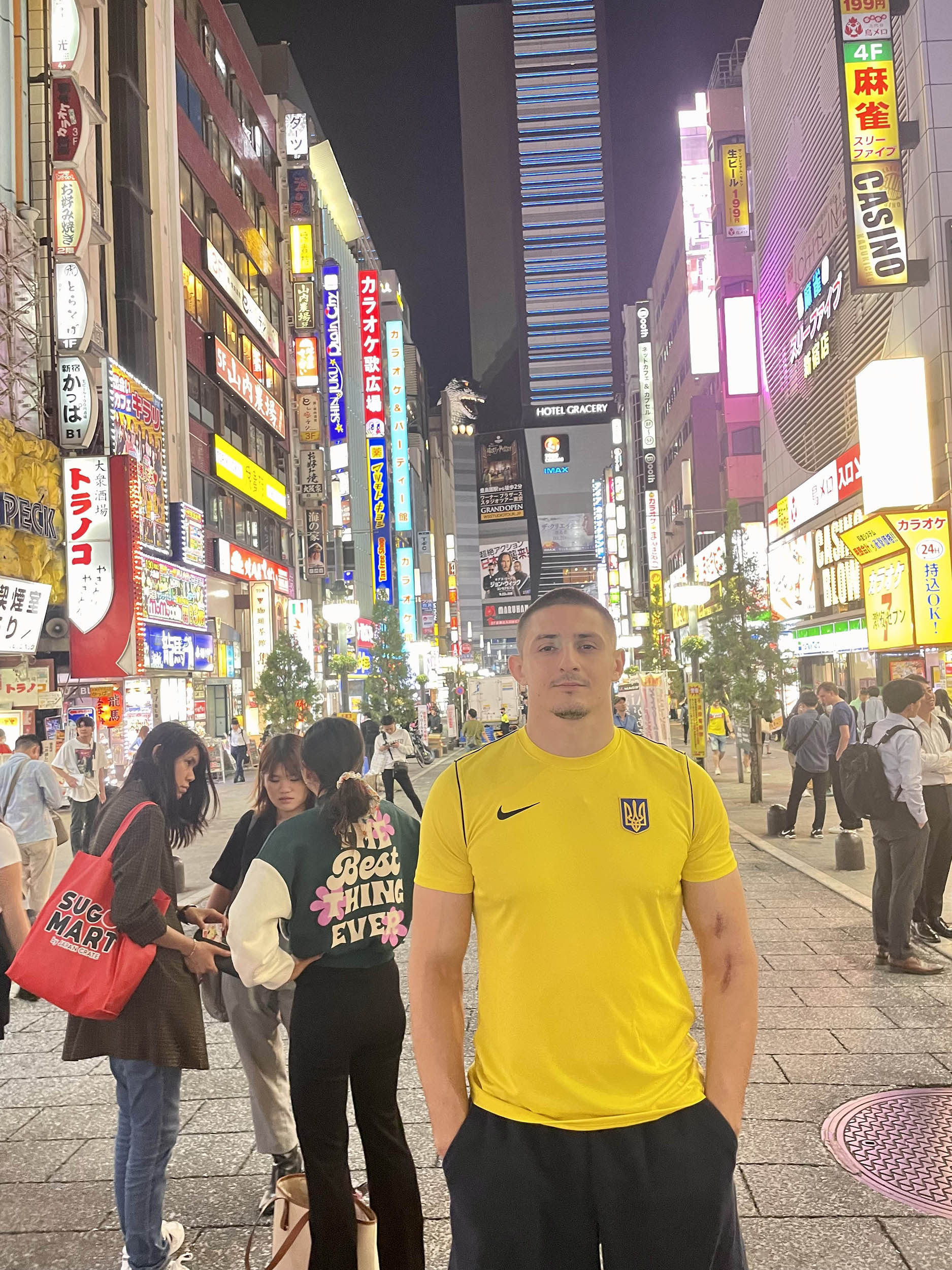
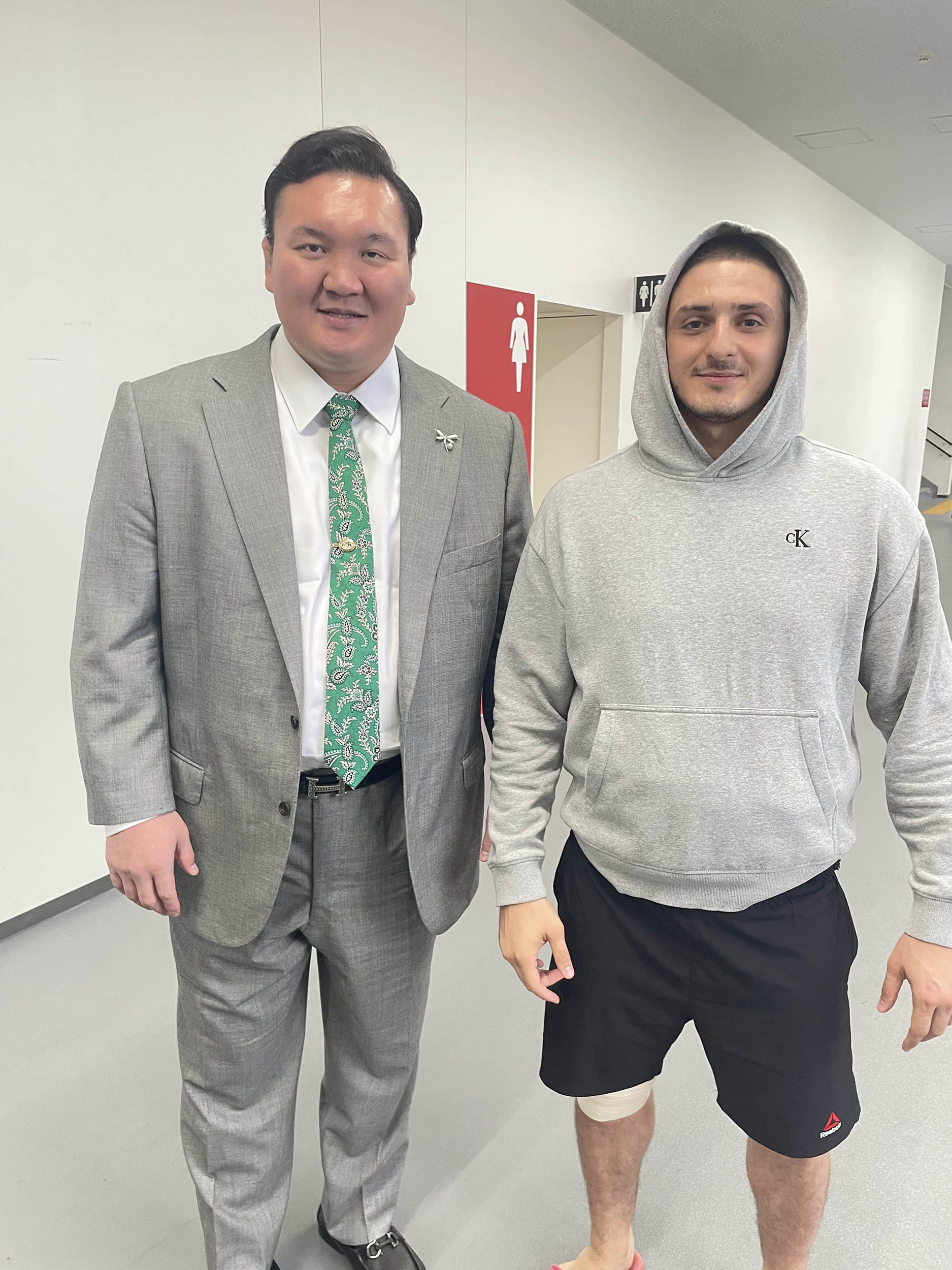
Anatolii's reverence for the sport's origins is matched by his pride in the athletic prowess of his homeland, which he sees as central to the growing popularity of sumo in Ukraine. "Sumo is quite an interesting sport," he explains. "It's a martial art with very simple rules."
Lyuba's perspective complements Anatolii’s personal experiences, illuminating the broader context of sumo's ascent in Ukraine. "For over a decade, Ukrainian athletes have held leading positions on the international stage," she details in her emails, her words painting a picture of a nation swiftly climbing the ranks in a sport that was once dominated exclusively by Japan.
This sentiment echoes through the gymnasium, a space where cultural crossroads meet. Anatolii's reverence for sumo’s origins is a mirror of the Ukrainian athletic spirit — a spirit that, according to Lyuba, has embraced sumo with fervent passion. "The success of Ukrainian sumo wrestlers," Lyuba asserts, "is likely ingrained in the genes of Ukrainians."
The Legacy of a Pioneer: The Ukrainian Roots of Sumo Excellence
Within the pantheon of sumo greats, there echoes the name of a pioneer with Ukrainian lineage — a figure who laid the foundation for Ukraine's affinity with sumo. The tale of Koki Taiho, half Ukrainian by birth, is often recounted in the halls where Ukrainian sumo enthusiasts gather, a story that blends the narratives of distant lands with the fighting spirit of Ukraine.
This wrestler's success is a beacon that has inspired generations of Ukrainian sumo athletes, showing that the sumo ring knows no borders and that excellence in this sport can have roots anywhere — roots that are as deep and enduring as the Ukrainian will. It's a sentiment that Lyuba echoes in her communication: "He was not just a wrestler; he became a symbol, intertwining Ukrainian resilience with the nobility of sumo."
But Ukraine’s modern sumo tale begins in 1999 with the establishment of the Ukrainian Sumo Federation and flourishes into a story of triumph and global recognition. "For more than a decade, Ukrainian athletes have held leading positions on the international stage," Lyuba writes, her prose imbued with a palpable sense of pride, accentuating the meteoric ascent of Ukraine in a sport previously alien to its cultural landscape.
Anatolii, standing amid his peers, is a testament to this ascent. “Ukrainian sumo has made a significant contribution to the global level," he says, his voice filled with the enthusiasm of a true devotee.
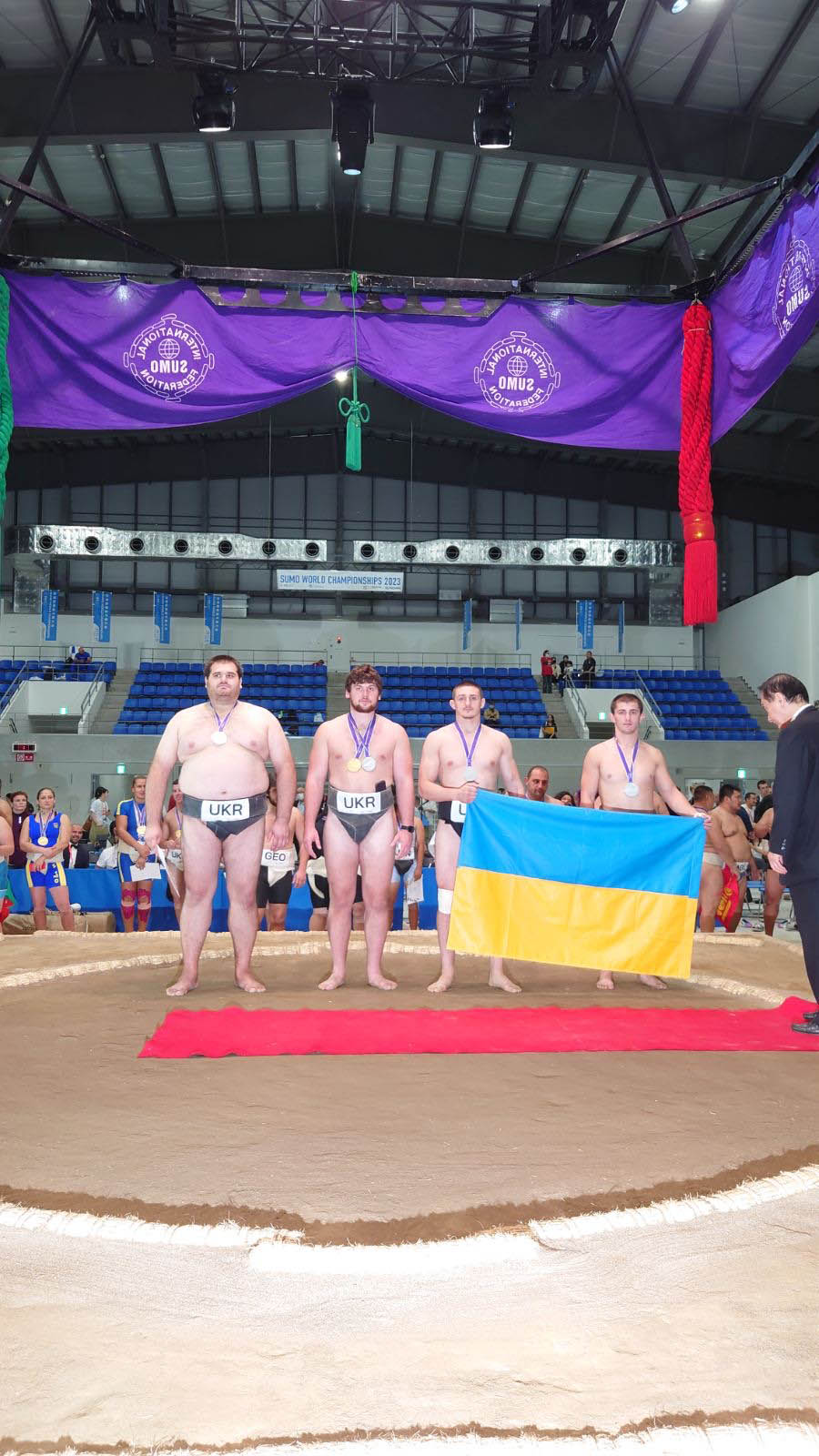
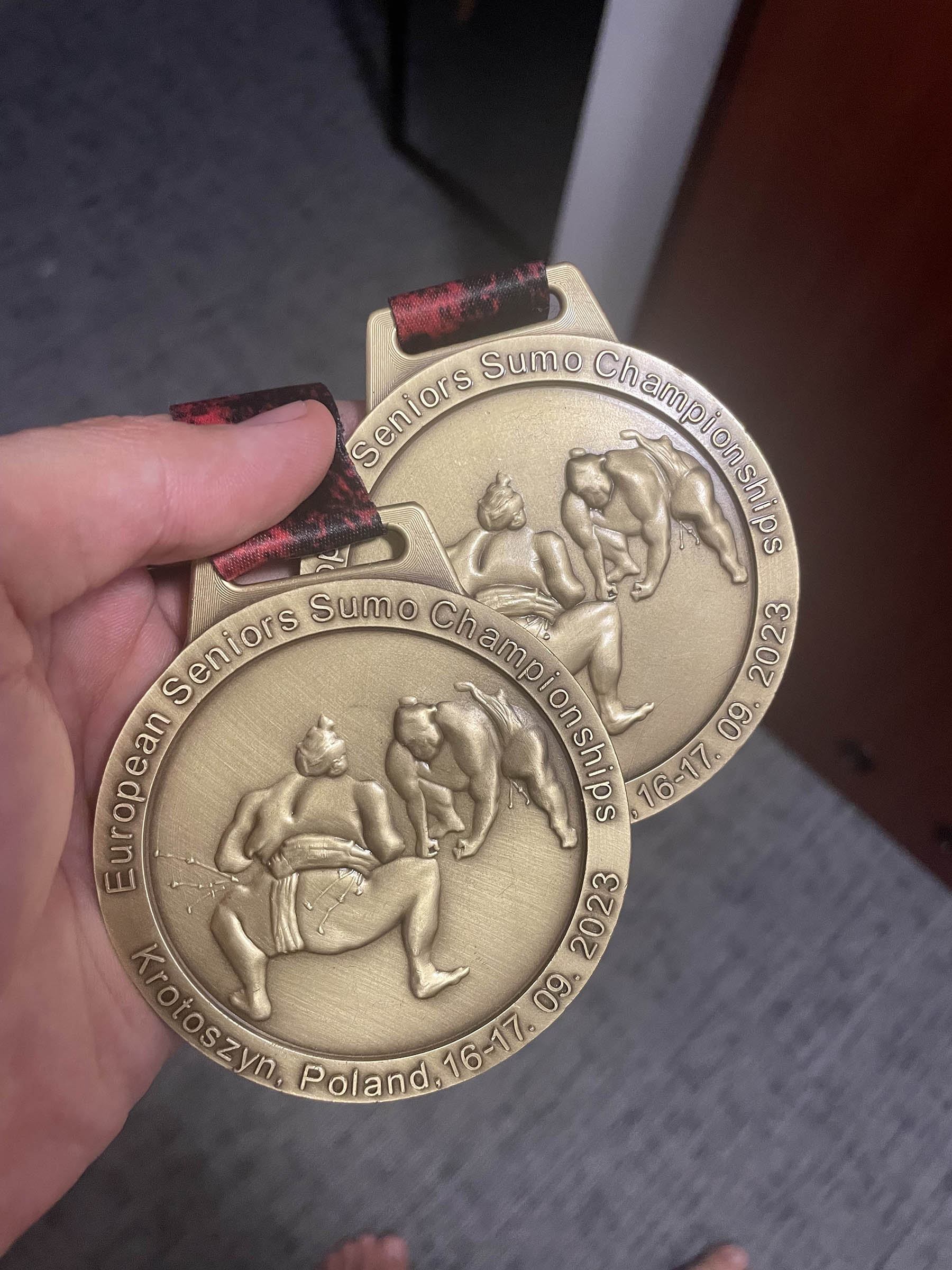
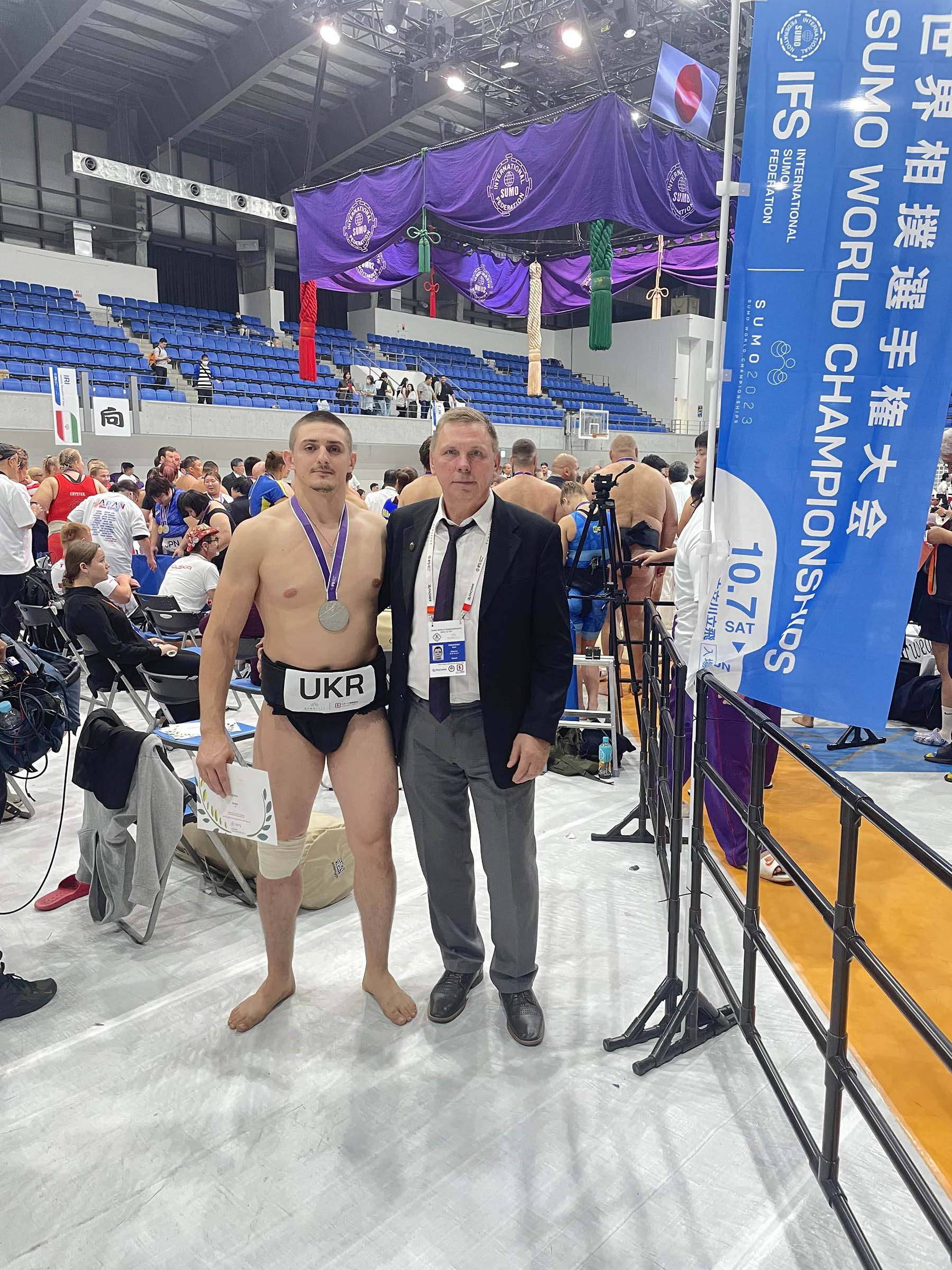
As Anatolii and his teammates move within the training space, their spandex undergarments a nod to modernity, there's a sense of history being written with each drop of sweat and every breath. Within the confines of this modest gym, the tenets of sumo — respect, strength, and honour — are given new life in Ukrainian soil. The ancient and the new converge, and the spirit of sumo is rekindled with a distinctly Ukrainian flame.
Lyuba goes on to describe how Ukrainian sumo, while honouring its roots, has also adapted to modern sensibilities. "Wearing a mawashi is mandatory," she explains, "but international rules now allow for adaptations, such as wearing black tights under the mawashi for men, in the spirit of a democratic approach to the sport. This has welcomed more athletes to sumo, respecting their cultural and personal preferences."
In Anatolii's unwavering stance and the assured grip of his hands on the mawashi, one perceives not only the power of a wrestler but also the pulse of a culture that has found profound value in sumo's discipline and artistry. The dojo, with its mirrored walls reflecting the wrestlers' forms, captures a scene where sport transcends boundaries, where the rich legacy of Japan and the spirit of Ukraine intertwine - a testament to the global spirit of sumo and the unique Ukrainian tenacity.
Navigating Traditions: The Complexity of Nudity in Sumo
In the deeply traditional world of sumo, where every ritual and attire carry centuries of heritage, the subject of nudity holds a particularly poignant space. Anatolii, in a moment of candid reflection, delves into his personal journey with the sport's age-old attire norms. "My initial feelings when I started wrestling in the nude ... It was a bit unusual and unclear why it was that way," he admits, recalling his early days stepping into the dohyō. This transition marked not just a physical change, but a deeper, symbolic embrace of sumo’s ancient customs, a rite of passage into its storied realm.
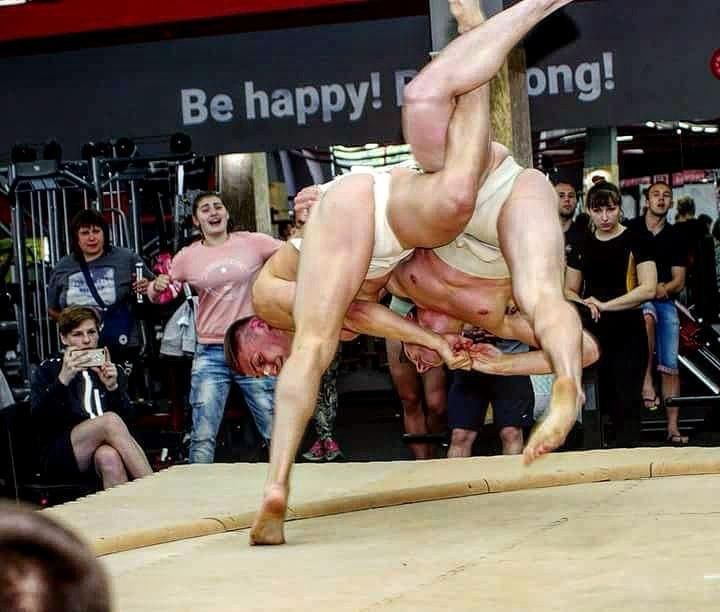
Yet, this traditional aspect of sumo attire contrasts sharply with the practices in women’s sumo. In an echo of modern sensibilities and evolving cultural narratives, female wrestlers adorn themselves differently. "In women's sumo, they are fully covered [from neck to knee]" notes Oleg, a seasoned coach whose insights draw from years of observing the sport's evolution. His words highlight a nuanced divergence from the male sumo practice, a thread in the fabric of sumo that weaves together tradition and contemporary perspectives.
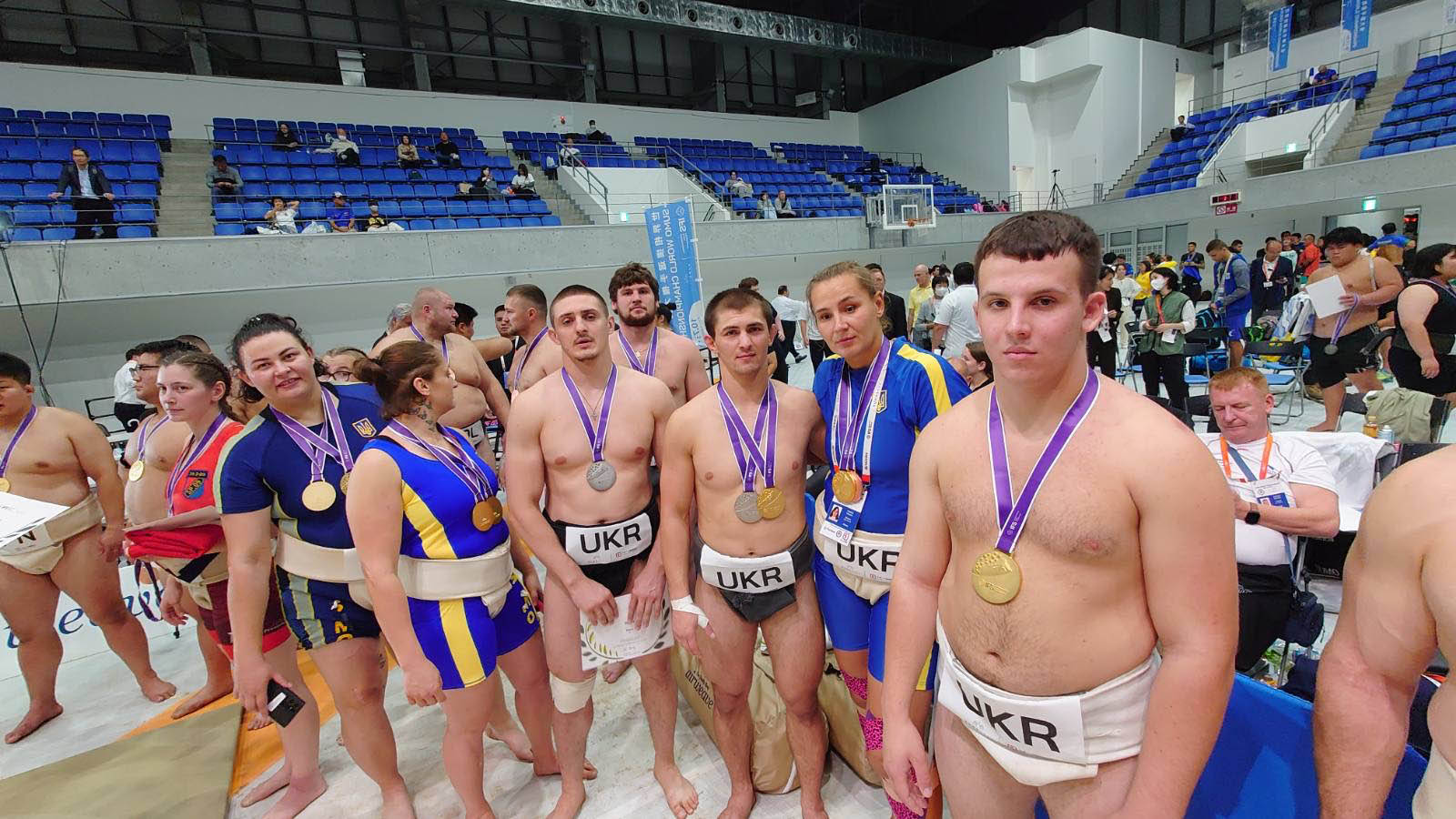
Speaking of Ukrainian male sumo wrestlers, Oleg further shares, "In training, it's convenient to wear spandex. Now, there's a choice at competitions - to wear it or not. Yet, many Ukrainian wrestlers prefer to wrestle naked, with only the mawashi.” His words paint a picture of a community that, while open to modern adaptations, often chooses to remain rooted in the elemental essence of sumo tradition.
This juxtaposition of attire in male and female sumo is more than a mere difference in clothing; it’s a reflection of sumo's journey through time, adapting and evolving while holding onto the threads of its rich history. It speaks to the diverse ways sumo wrestlers, bound by a common love for the sport, navigate through its rituals and symbols, each finding their own balance between the ancient art's sacred legacy and the shifting sands of the modern world.
Embracing the Dohyō: The Dance of Discipline and Culture for a Ukrainian Sumo Wrestler
The dohyō, with its worn mats and echoing cadence of exertion, is a sanctuary for Anatolii and his fellow sumo practitioners. It's a place where the air is thick with the spirit of determination, where each drop of sweat on the canvas is a testament to their dedication. The Ukrainian spirit, known for its robustness and resilience, finds a kindred essence in the discipline of sumo, a sport that demands everything from those who dare to tread its sacred grounds.
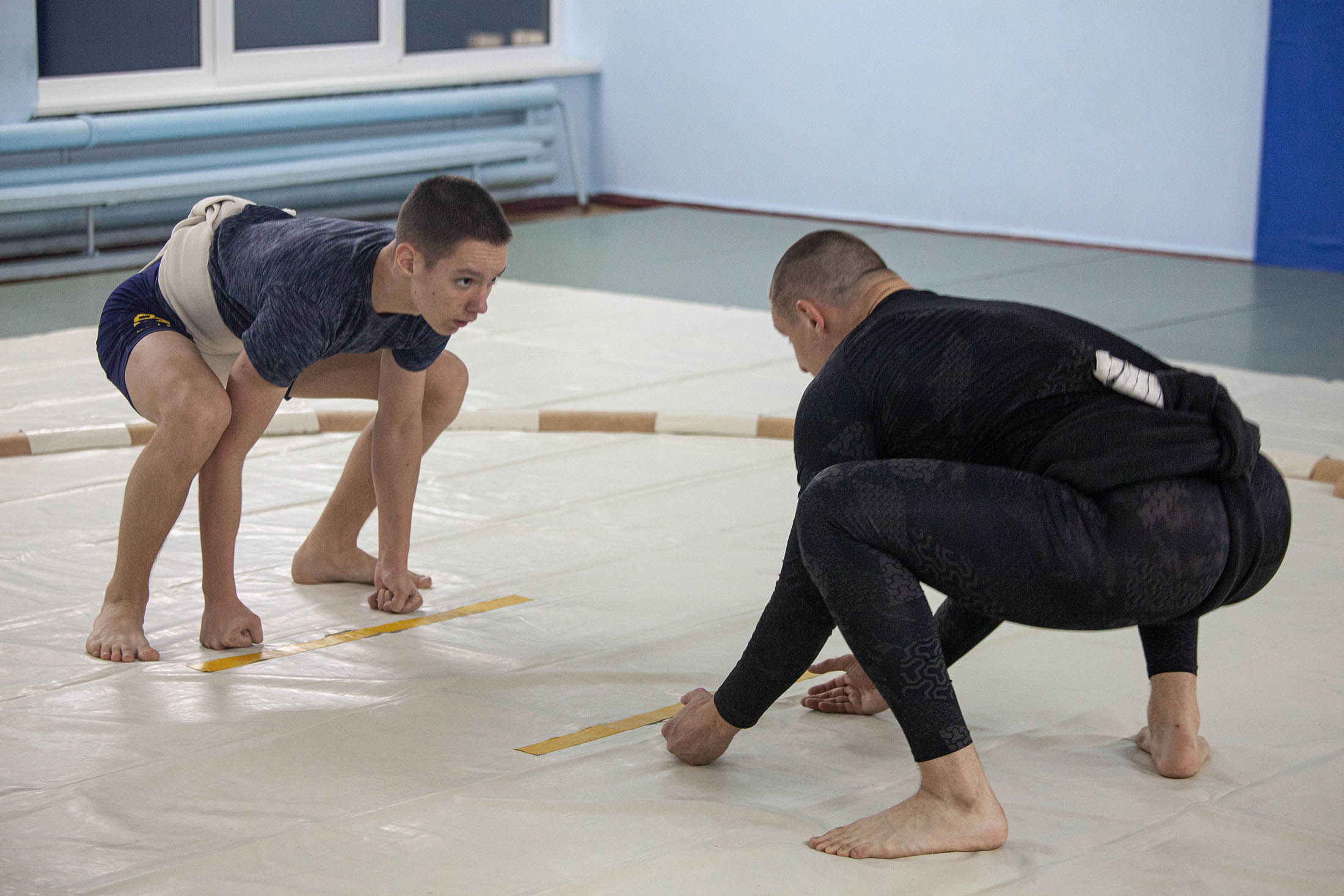
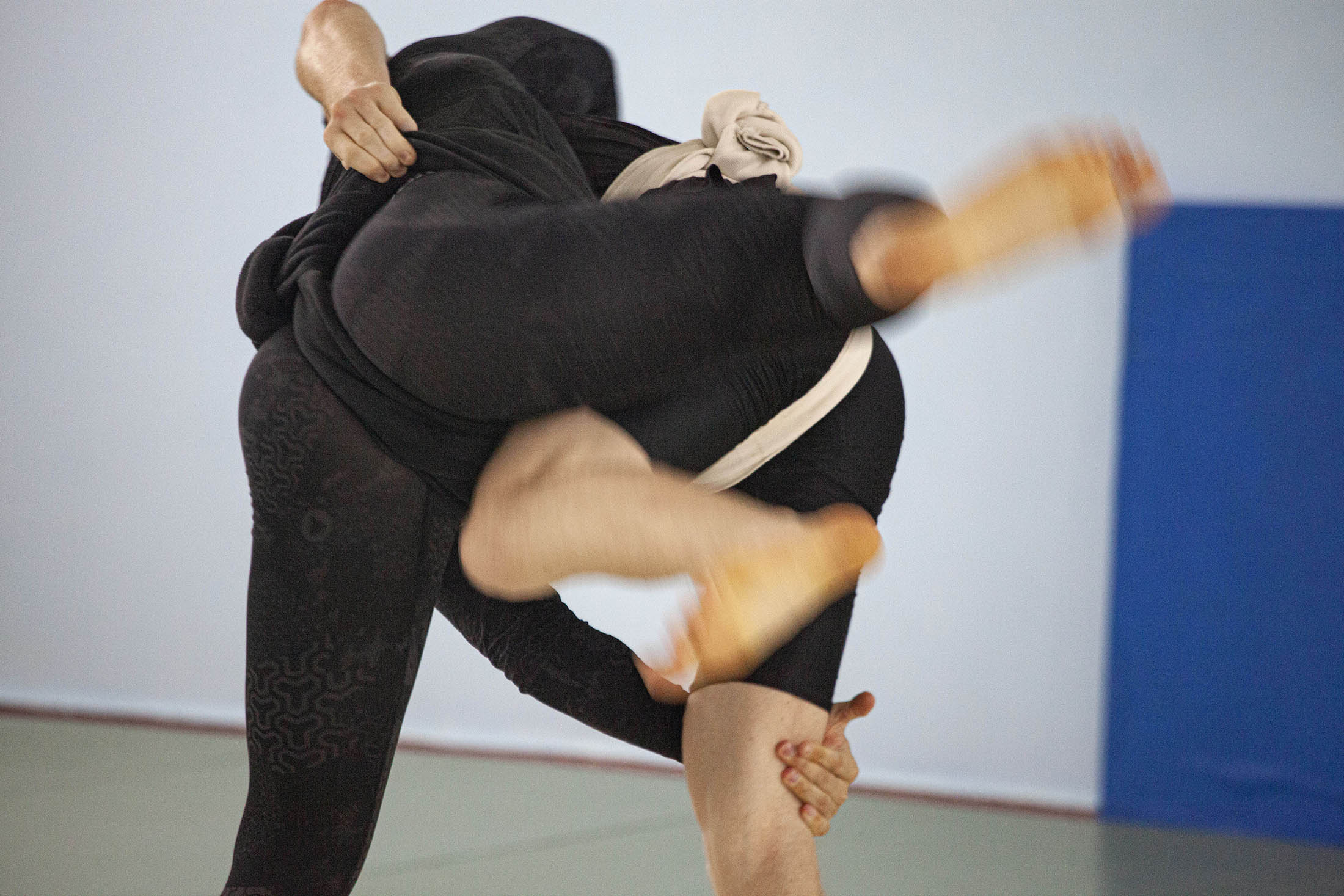
Anatolii, with his commanding presence and unwavering focus, is a central figure in this temple of tradition and strength. His training regimen is more than preparation for competition; it's a form of communication, expressing respect for his opponents, the sport, and the rich cultural tapestry that sumo weaves. "Sumo isn't just about the physical confrontation," Anatolii muses, his gaze steady, "it's about honour, respect, and the unspoken bond between wrestlers."
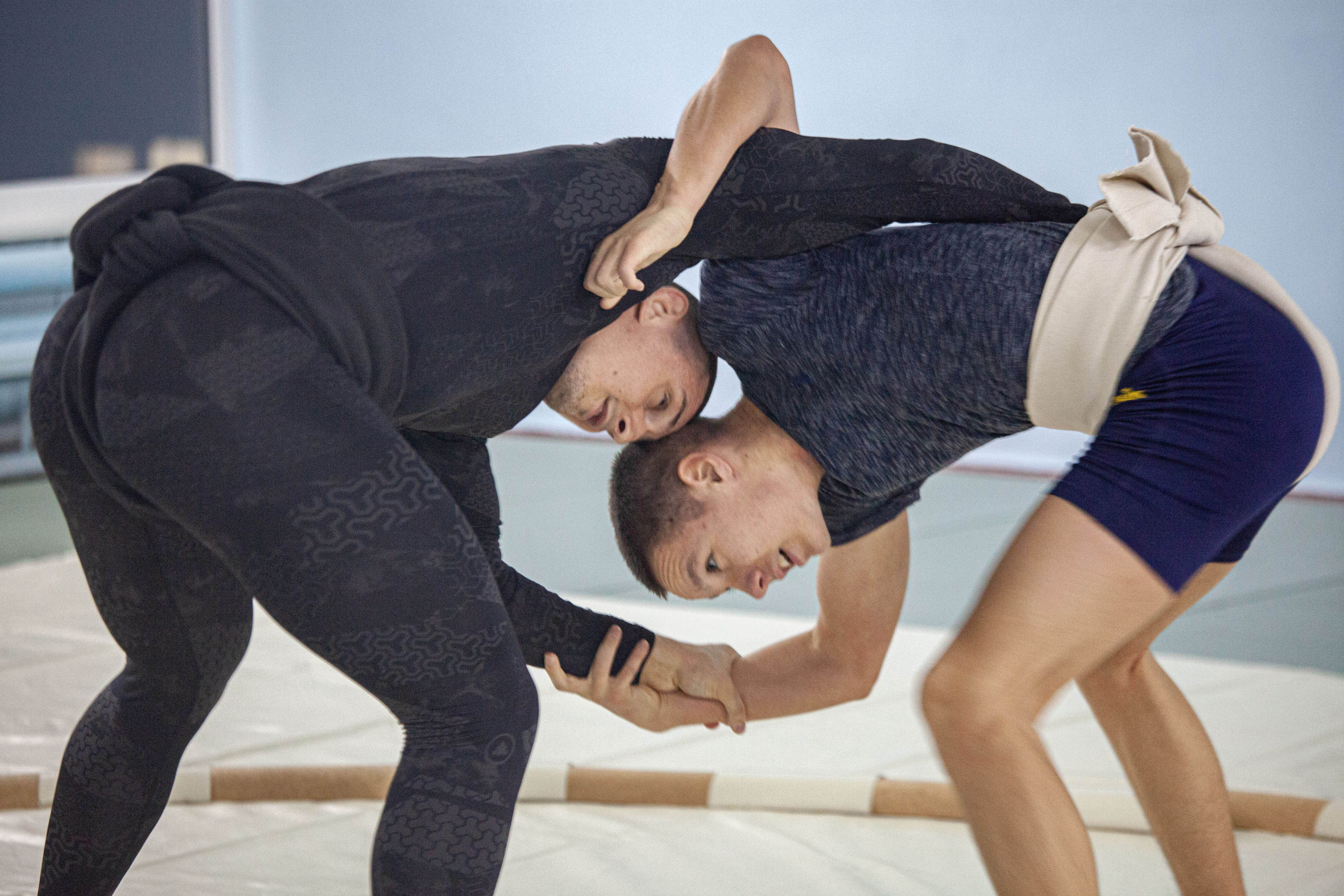
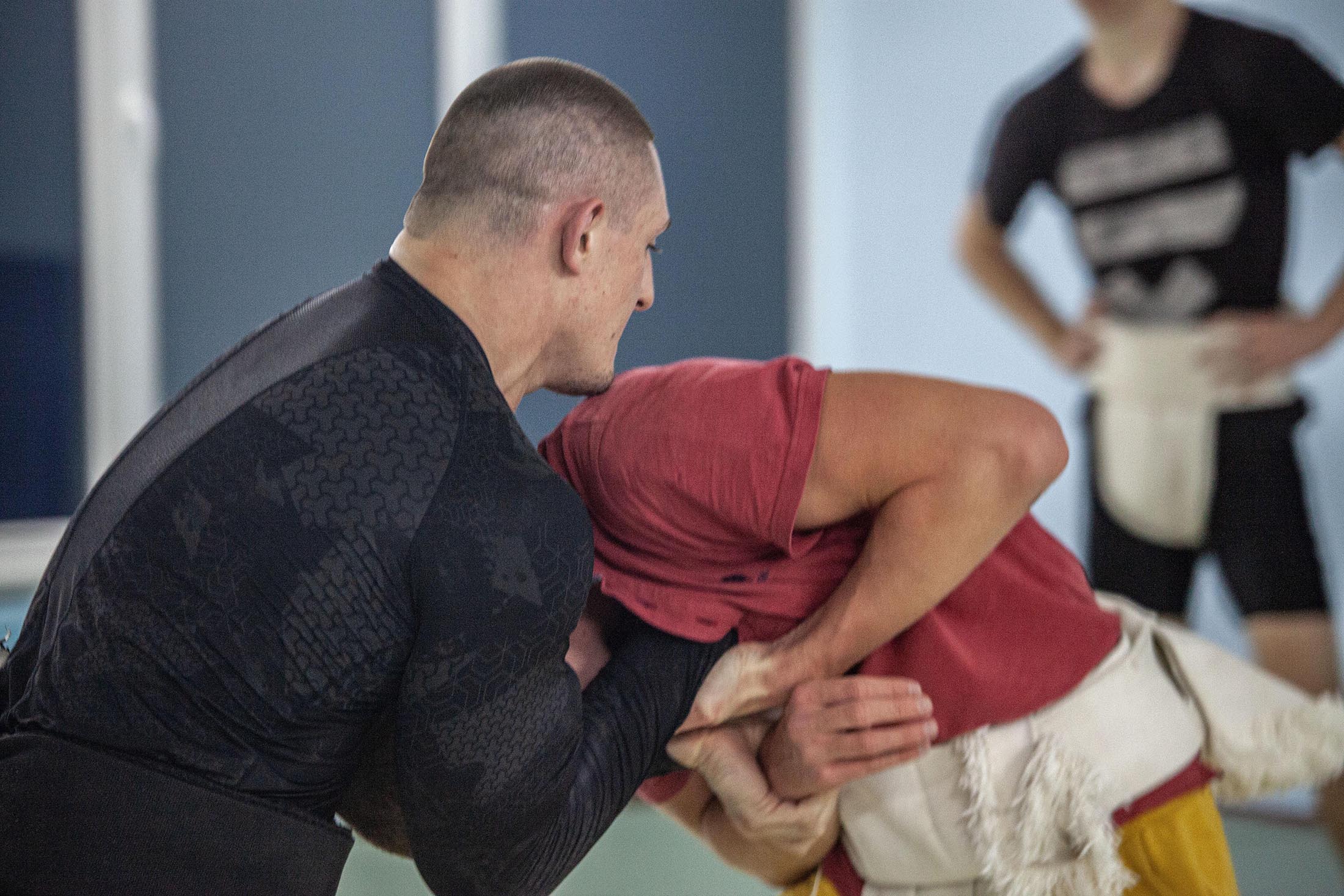
The dohyō is a microcosm of the world stage where Ukrainian sumo wrestlers have etched their names. Anatolii and his comrades train with a profound understanding of the weight they carry - the expectations of a nation and the respect for an art that transcends borders. It's here that Anatolii's role as a mentor comes to the fore, as he guides the younger generation, imparting the wisdom of the sumo elders and the fighting spirit of his homeland.
Cultural Heritage and Global Ambitions
Lyuba's emails resonate with a tone of pride when she discusses the cultural heritage that sumo represents and the global ambitions it inspires. "Ukrainian sumo is a celebration of our heritage and an emblem of our aspirations on the global stage," she writes. According to her, the Sumo Federation of Ukraine has been instrumental in fostering a community that honours the traditional aspects of sumo while embracing the nuances that come with international competition.
Anatolii stands as a figurehead of this community, a man whose journey in sumo has been as much about personal growth as it has been about achieving athletic excellence. "Every match, every tournament is another step in our journey to show the world the strength and heart of Ukraine," he declares, a fire of conviction burning in his eyes. His words are not just a reflection of his personal aspirations but echo the sentiments of a nation seeking to make its mark through the noble art of sumo.
The Sumo Federation: A Conduit for Cultural Exchange
The Ukrainian Sumo Federation, under the diligent stewardship of individuals like Lyuba, has become a conduit for cultural exchange and athletic development. Through their efforts, athletes from various regions of Ukraine come together, united by their passion for sumo. "We are building bridges," Lyuba notes, "not just between our athletes and the world, but also within our own diverse communities."
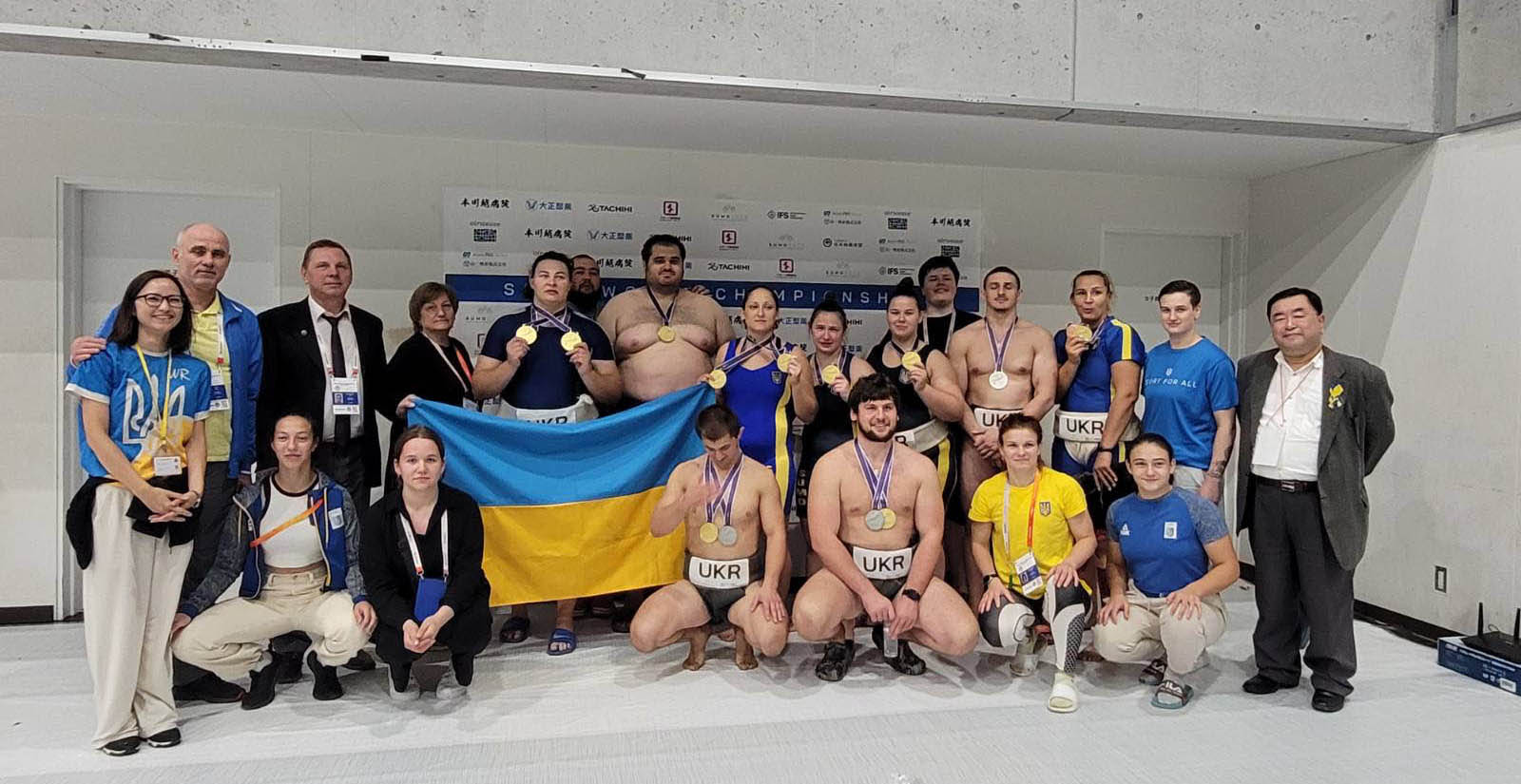
These efforts have borne fruit, as evidenced by the increasing number of Ukrainians making waves in international sumo competitions. "Our athletes are ambassadors," Lyuba explains, "carrying the legacy of Ukrainian sumo with them wherever they compete." This legacy is not just about victories and losses but about showcasing the indomitable spirit that characterises Ukrainian sumo.
Future Carved in Tradition and Triumph
As the session in the dohyō wraps up, Anatolii, the champion Ukrainian sumo wrestler, looks towards the future with a sense of hope and determination. The path ahead is fraught with challenges, both in the sumo ring and beyond, but it's a journey he embarks on with the steadfastness of a warrior. His aspirations are clear - to continue to elevate the sport of sumo within Ukraine and to carry the honour of his nation onto the international stage.
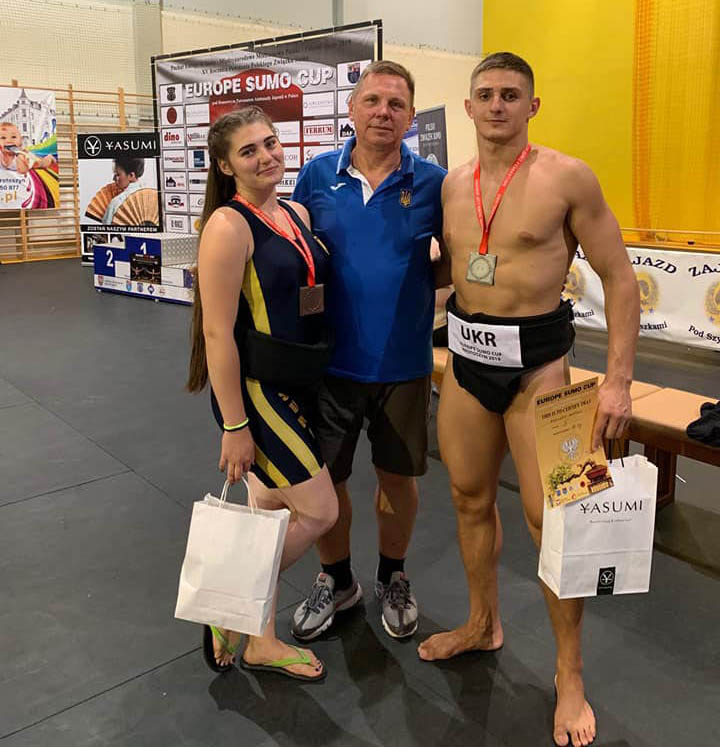
The dojo grows quiet as the wrestlers depart, leaving behind a space hallowed by their efforts. Anatolii remains for a moment, collecting his thoughts, his black mawashi a symbol of the journey he has undertaken — a journey of valour, virtue, and the promise of victory.
In the story of Anatolii, the sumo sentinel of Ukraine, we find the embodiment of a nation's strength and the universal quest for excellence. His tale is one of combat and compassion, a testament to the power of sports to unite, inspire, and transcend. Through Anatolii's eyes, the world of sumo is not just a competition of might but a dance of cultures — a testament to the enduring spirit of Ukraine.
